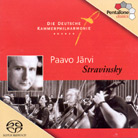May 2004
L’Histoire du Soldat was a chamber "opera" that broke all the rules, setting new ones. Actors were mixed with pantomime and instrumental music to tell the more or less traditional story of a man who makes a deal with the devil. This time the man is a solider coming home from the war, and the devil is a fiddle player. The composer wrote for seven players, a high and low instrument from each orchestral family (violin and double bass for strings, clarinet and bassoon for woodwinds, and trumpet and trombone representing the brass) plus percussion. Ragtime was written about the same time as L’Histoire and explores, in classical terms, the popular dance of the era. The concertos were written for particular occasions under commission. The suites for small orchestra are based on earlier compositions and pay homage to the dance. The first suite is comprised of international dances; the second is a Stravinsky view of ballroom dancing. I did not know what to expect from this recording. The conductor, Paavo Järvi, is now music director of the Cincinnati Symphony Orchestra and his recent recording of Petrouchka with that orchestra was something of a boring and pedantic dud. But the performances of these smaller works turned out to be opposite: alert, arresting, energetic, alive, and charming. Perhaps it was the inspiration provided by the virtuoso players of the relatively new German chamber orchestra, founded in 1980. Whatever the cause, it would be difficult to imagine better readings this music. I also had not expected too much from the PentaTone engineers. The SACD recordings thus far have been largely B+ -- very good but nothing to put on the "must have" list. But this one has a different team of German engineers and the results are absolutely A+. In the SACD advanced-resolution multichannel version, each instrument has "right in your listening room" presence, without any trace of stridency. The bass drum is incredible; you can hear the stroke and then the shudder of the membrane. Same with the violin in L’Histoire. You can sense the stroke, then hear the sound. Usually, with this kind of sound, one feels as though the instrument has been shoved into the microphone, but not here. This is a recording of demonstration caliber for a new format that allows intricate resolution. So, surprise, I had not expected it, artistically or sonically, but in both departments, this hybrid SACD is a must-have recording for all collections. GO BACK TO: |
 Stravinsky:
Stravinsky: Suite from "Histoire du soldat", Ragtime, Petit choral, Dumbarton
Oaks, Concerto in D, Suites for Small Orchestra Nos. 1 & 2
Stravinsky:
Stravinsky: Suite from "Histoire du soldat", Ragtime, Petit choral, Dumbarton
Oaks, Concerto in D, Suites for Small Orchestra Nos. 1 & 2 Stravinsky lived a
long and fruitful life and always remained inventive and adventurous. He composed in
several different styles throughout his exciting lifetime. Those who know only his early,
post-romantic style that included the three great ballets, Le Sacre du Printemps,
The Firebird, and Petrouchka, are urged to hear this disc for the other
side. Most of these works are for small orchestra or even smaller ensemble combinations
and come from the period when the composer was after clarity, a goal achieved by going
back to classical forms and styles.
Stravinsky lived a
long and fruitful life and always remained inventive and adventurous. He composed in
several different styles throughout his exciting lifetime. Those who know only his early,
post-romantic style that included the three great ballets, Le Sacre du Printemps,
The Firebird, and Petrouchka, are urged to hear this disc for the other
side. Most of these works are for small orchestra or even smaller ensemble combinations
and come from the period when the composer was after clarity, a goal achieved by going
back to classical forms and styles.